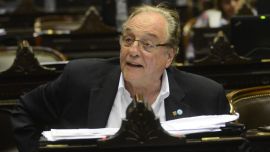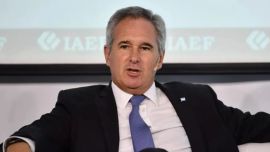Tucumán elects its future governor tomorrow, as will three other provinces (along with last week’s column Entre Ríos in addition to Chubut and Jujuy, both previously covered, as well as the PASO primary in the key province of Mendoza), sandwiched between two other gubernatorial elections last weekend with four more to come next Sunday – there’s a whole lot of voting going on in the first half of this month but then nothing until the PASO nationwide primary on August 11. This year’s trend of incumbent provincial governments retaining power by generous margins was sustained last weekend in Misiones and San Juan – and there’s little to suggest much change in the third of districts voting this Sunday and next.
Argentina’s smallest province, where independence was declared in 1816, is also its most densely populated and the same could be said about tomorrow’s electoral offer. There are no less than 18,651 candidates competing for just 347 electoral prizes (49 provincial assembly seats, 19 town halls, 184 municipal council seats and 93 communal delegates, apart from the governor and lieutenant-governor) thanks to a permissive electoral law allowing party lists to be formed by groups basically looking for a local government job for the next four years and without provincial candidates of their own (names from other fronts are tacked on) – it was much worse in the last general elections in 2015 with over 25,000 candidates.
Nine of these candidates are after the top job – incumbent Peronist Governor Juan Luis Manzur is seeking re-election against the comeback bid of his threeterm Kirchnerite Radical predecessor José Alperovich (thus making Tucumán the only province without either a smooth succession or unopposed continuity), while President Mauricio Macri’s Cambiemos (Let’s Change) national government is championed locally by Radical Senator Silvia Elías de Pérez. The other major candidate is rightist Ricardo Bussi, whose father, the late ex-general Antonio Domingo Bussi, ruled Tucumán both as a military trustee (1976-7) and as an elected governor (1995-9). Three candidates are competing for the leftist vote.
The opinion polls are highly erratic and seem mercenary, giving the client the figures he or she would like to see. Most (not all) polls show Manzur ahead with 30 to 40 percent but there is a variation of at least 100 percent for the other three – Alperovich anything from 17 to 34 percent, Bussi 11 to 26 percent and Elías de Pérez 11 to 23 percent. A couple of polls give Alperovich a double-digit lead, one poll has Bussi running second, another Elías de Pérez, etc. etc. But what do seem undeniable are Macri’s overwhelming negative popularity ratings in Tucumán, rejected by 80 to 90 percent of the population. This was not always so. Upon taking office Macri not only launched the ambitious Belgrano Plan to develop northern infrastructure but placed it under Tucumán Radical deputy José Cano (the George Clooney lookalike whose victory claims in the tight 2015 gubernatorial race were entirely plausible). This made a bright start, especially a major expansion of Tucumán airport which hugely boosted local lemon and other exports. But within 20 months Cano had been bounced amid graft allegations and the lemons have been increasingly sour ever since.
Tucumán’s three senators – Alperovich and Beatriz Mirkin, his running-mate tomorrow, for the Victory Front, confronting gubernatorial rival Elías de Pérez – can stay in their seats until 2021 should Manzur (or Bussi) win but five of the nine deputies must defend their seats this year. These are the Victory Front’s Walter Santillán and Alicia Soraire together with Peronist José Fernando Orellana as against PRO’s Facundo Garretón and María Teresita Villavicencio, who backs the Martín Lousteau wing of the Radical party. This three-to-two ratio is likely to persist unless Macri’s uniquely high unpopularity is fully transferred to his local candidates, thus giving Peronism a fourth seat. The four deputies continuing until 2021 are Peronists Gladys Medina and Pablo Yedlin, the Radical Cano and Beatriz Avila of the Social Justice Party (which responds to Germán Alfaro, the Peronist mayor of the provincial capital San Miguel who backed Cano in 2015 and has been close to Macri, especially in the first half of his term). Apart from Cano, none of these deputies have made much of a name for themselves aside from Avila (a mother of triplets) being one of the most strident voices against last year’s abortion bill. But Garretón’s background as a software entrepreneur is an interesting break from the dozens of lawyers filling the Lower House while Yedlin is a doctor like former Health minister Manzur and Cano a dentist.
Turning to provincial history, ancient indigenous civilisations have left their traces in the ruins of Quilmes (nearly 1,300 kilometres from the Greater Buenos Aires district). San Miguel de Tucumán was founded in 1565, quickly displacing the older Santiago del Estero as the northern colonial centre. Apart from the declaration of independence, the region contributed to the patriotic cause with the victorious battle of Tucumán in 1812 and became a province in 1814. Since then the province has often been a pioneer of industrial development one step ahead of other regions – its sugar refineries (65 percent of Argentine sugar production) date from 1860 while the Tafí Viejo marshalling yards from the last quarter of the 19th century were the heart of Argentina’s railway system (now virtually dismantled for the last three decades). The ferocious 1975 Operation Independence repression of Marxist guerrillas briefly ruling wide rural areas was something of a hiatus for the province, which has struggled to recover its dynamism and prosperity ever since. But Tucumán University remains highly respected.
In its first strife-ridden century Tucumán had no less than 80 changes of government with 64 governors. The next seven decades until the return of democracy in 1983 were no better with trustees (including later junta chief Jorge Videla in 1970) outnumbering elected governors by 42 to 13. Apart from Bussi, all recent governors have identified with Peronism – Fernando Riera (who had a strange vampiresque allergy to daylight, forcing him to work at night) from 1983 to 1987, José Domato (1987-91), the crooner and Carlos Menem protégé Ramón ‘Palito’ Ortega (1991-5) and the oilfield trade unionist Julio Miranda (1999-2003), followed by the originally Radical Alperovich until Manzur in 2015.
Tucumán has over 1.7 million people (1,448,200 in the 2010 census) in its 17 departments, of whom some 800,000 live in the metropolitan area of the provincial capital. Yerba Buena (around 75,000) is the second city, followed by Concepción, Simoca and Tafí del Valle. No space remains for the tourist attractions, which can be summed up under its proud name: “The garden of the republic.”
#20 Tucumán
Electorate tomorrow: 1,226,117
Governor: Juan Luis Manzur (Peronist)
Senators: Three (2 Victory Front, 1 Radical)
Deputies: 9 (Peronists, 2 Victory Front, 3 Cambiemos including 1 Radical, 1 PRO and 1 Lousteau Radical, 1 Social Justice)
On the ballot: 5 of 9 deputiesrelated news





















Comments